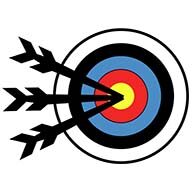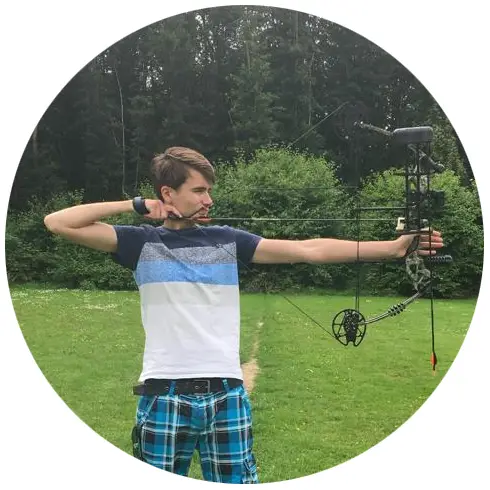For outsiders, archery might seem simple. You buy a bow and some arrows and start shooting. Therefore, a lot of new archers forget to take their draw length into account. This causes a lot of archers to buy a bow that is too short for them. In this article, we will discuss why you shouldn’t shoot a too-short bow and what you can do when your bow is too short. No time to read on? Read at least the next paragraph.
Shooting a too-short bow can cause a lot of issues. The first issue is that it can severely reduce the lifespan of the bow. The second issue is stacking, which makes it more difficult to hold the bow. This also makes your bow less efficient. Therefore, you should either buy a longer bow or decrease your draw length.
In the remainder of this article, I will discuss the issues with a short bow in more detail. I will also explain how you can see whether your bow is too short and whether a bow can be too long. At the end of this article, I will explain how you can still shoot a short bow and how you choose the right bow length.
Confusing terminology
The term short bow is quite confusing because it can indicate different things. For takedown recurve bows, we often indicate the three different limb sizes with short, medium, and long. Therefore, you could call bows with short limbs a short bow.
Short bows are also used to state the difference between longbows and shorter bows within traditional archery. Therefore, any bow that isn’t a longbow is considered short. This would include any recurve bow.
So, it seems quite unclear what a short bow even is. Generally, I like to think about how the bow fits the archer. If you have a kid with a 70-inch bow, that bow will be too long. For me, however, that bow would fit me perfectly. Therefore, I will use the following definition:
A too-short bow is a bow that the archer cannot or should not shoot at full draw.

Issues with a too-short bow
So, why shouldn’t you shoot with a bow that is too short for you? In this section, I will give you two very good reasons.
It decreases the lifespan of the bow
Just because you can draw a bow further than its intended draw length doesn’t mean you should. Every bow will break at some point if you keep drawing it further. For some bows, this might be at 28 inches, while others will snap at 35 inches.
Most bows are quite resistant and will not snap when you overdraw it. Even when you go beyond 5 inches of the recommended draw length. But if you do this repeatedly, you will severely limit its lifespan. This is especially the case with wooden bows. Carbon and fiberglass bows tend to be more durable.
Stacking
Stacking is the exponential increase in draw weight that happens at the end of your draw. This happens when the bow is drawn further than its intended draw length.
Stacking makes the bow harder to draw and severely decreases its efficiency. Bows without stacking are more forgiving, easier to shoot, and shoot harder. I discuss the principle of stacking in more detail in the article below:
Stacking – what it is and why it’s bad
How you feel if your bow is too short
The easiest way to find out whether your bow is too short is to find for what draw length your bow is rated for. You can find this information either on the seller’s or manufacturer’s website. You can also often find this in the owner’s manual.
Most often these ratings are quite conservative. In most cases, drawing the bow back 1 or 2 inches doesn’t matter too much. Below I will discuss some clear indicators that your bow is too short.
The draw feels uncomfortable
When a bow is too short, the last few inches of the draw might feel uncomfortable. A bow should have a smooth draw, but when you overdraw it may feel gritty. When you experience this, the bow is probably too short for you.
You can’t draw the bow to your anchor point
This could also be due to the draw weight of the bow. But some bows just lockout when you overdraw them. This means that the draw weight increases so fast that it’s impossible to draw any further.
The bow has serious stacking issues
It can sometimes be quite difficult to distinguish between stacking and whether your bow is simply too heavy for you. Some archers complain that their bow stacks while the bow is just a bit too heavy for them. The only real way to figure out whether your bow stacks is to measure it, as we discuss in this article.
The bow starts to make noises
If your bow starts to make noises this indicates that the bow is under extreme stress. This is a bad sign and indicates that your bow might break at any time. So, if this is the case, you either have a bad pair of limbs or you overdraw the bow.
You have a long draw length
If you have a draw length of 25 inches, almost no bow will be too small for you. Most bows work fine at 25 inches and beyond. Only children’s bows and extremely short bows might cause you issues.
If your draw length is 30 inches or more, there are a lot of bows that will be way too small for you. Most archers have a draw length around 27-28 inches, so a lot of bows are only rated at 28 inches. If you draw these bows till 31 inches, you might experience issues.
Generally, taller archers have a longer draw length, but it also depends on your overall form. Read the article below, for information on how to measure or estimate your draw length:
How to measure your draw length
Can your bow also be too long?
We already discussed why your bow shouldn’t be too short. But what if your bow is too long? Can that also cause issues?
Generally, a bow can’t be too long, it can only be longer than necessary. This means that the bow is heavier (in terms of weight) and more difficult to wield. That doesn’t negatively influence your shot, however. A long bow will shoot fine at short draw lengths.
Some archers think that a long bow is less efficient when it’s shot with a short draw length. But this is not true. It will shoot the same as a shorter bow. It might even be a benefit because the draw tends to be smoother. Therefore, it’s often recommended to senior archers to shoot with a longer bow.
So why doesn’t everybody shoot with long limbs, why do we have different limb sizes? Well, it’s mainly based on personal preferences. I can imagine that a 70-inch bow, might seem too big for an archer that is 5’1’’ (165 cm). The bow would be a lot bigger than the archer.
In general, shooting a bow that is longer than necessary isn’t an issue. If you can shoot comfortably with it, it shouldn’t cause you any trouble.
How to choose the right bow length
Alright, let’s discuss how to choose the right bow length. Since this depends on the type of bow limbs and riser, I discuss four different bow types.
Takedown recurve bows (Olympic recurve bows)
Most target archers shoot with a takedown recurve bow. These bows are meant for competitive archery. If your bow has a wooden riser, I would consider it a beginner’s bow. So, skip to the next section if that is the case.
Takedown recurve bows have two riser sizes: 23 and 25 inches. The 23-inch riser is meant for children and the 25-inch riser for adults. As mentioned earlier, we have 3 different limb sizes: short, medium, and long. If we combine this with the 25-inch riser, we get 3 sizes. Which you can find below:
| Max draw length | Limbs | Bow length |
| 26 inches | Short | 66 inches |
| 28 inches | Medium | 68 inches |
| 30 inches | Long | 70 inches |
Read the article below, if you want more information on how to choose the right limbs for takedown recurve bows. I also discuss how to choose the right bow limbs for children.
How to choose the right limbs for your bow
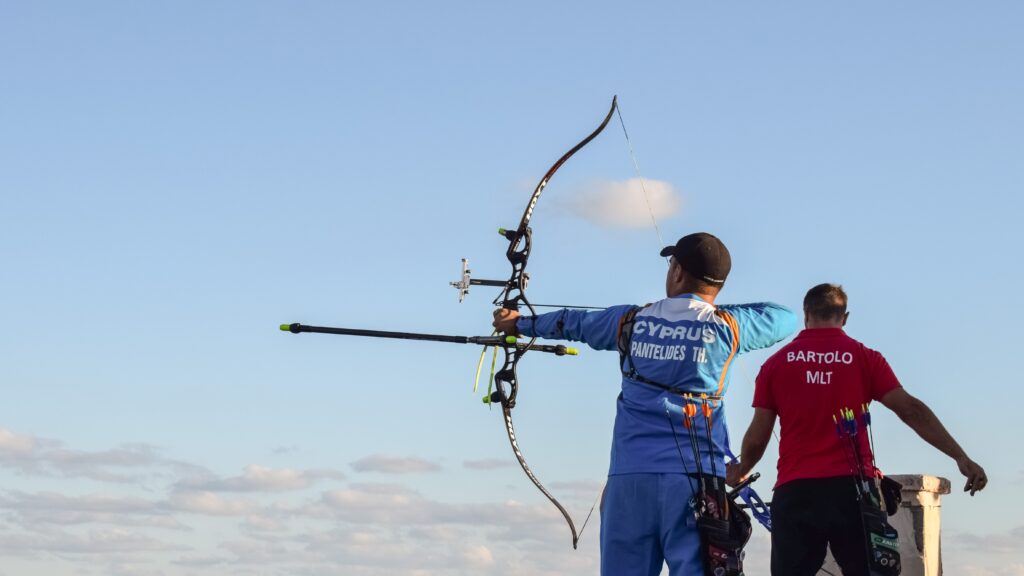
Fixed limb recurve and beginner’s bows
Generally, the riser of beginner’s and fixed limb bows are shorter. Therefore, more length of the bow is comprised of the limbs. These bows can, therefore, be a bit shorter than takedown recurve bows. Therefore, I have the following recommendations:
| Max draw length | Limbs | Bow length |
| 26 inches | Short | 64 inches |
| 28 inches | Medium | 66 inches |
| 30 inches | Long | 68 inches |
Most of these bows list their maximum draw length. So, use that instead if it’s listed.
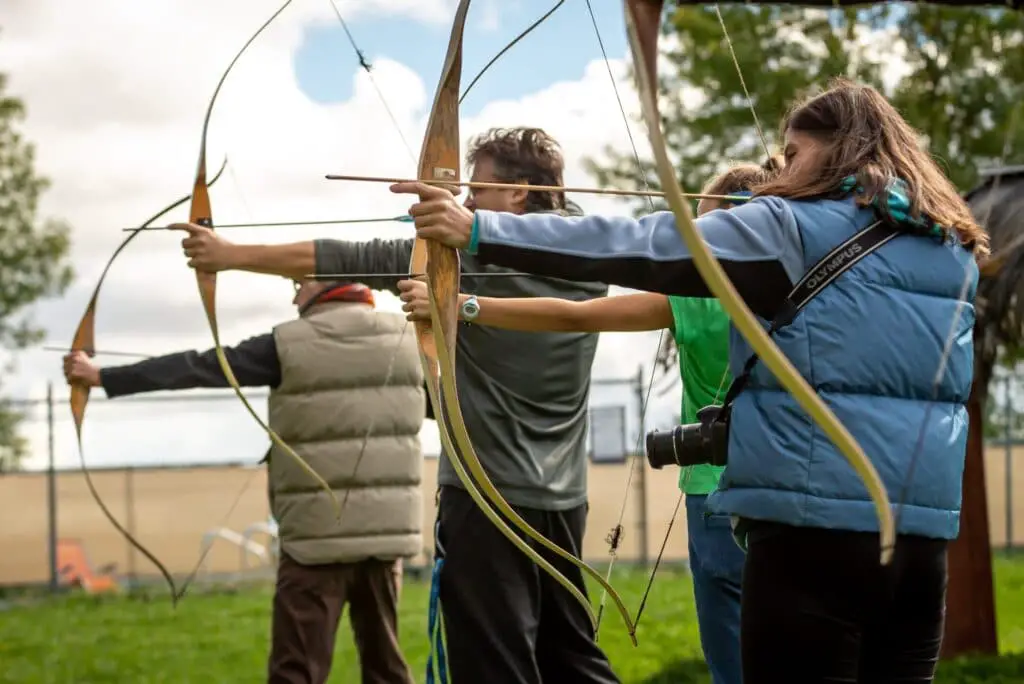
Mongolian bows
All bows we mentioned earlier are recurve bows. But how much the bows are recurved also matters. Bows that have stronger recurves require a shorter bow length. In most cases, the manufacturer will provide you with a maximum draw length recommendation. But if that isn’t available use the table below:
| Max draw length | Limbs | Bow length |
| 26 inches | Short | 62 inches |
| 28 inches | Medium | 64 inches |
| 30 inches | Long | 66 inches |
In most Asian archery styles, you draw less far than European archery styles. But I am no expert in these shooting styles. So, you might want to gather some additional information before buying this type of bow.
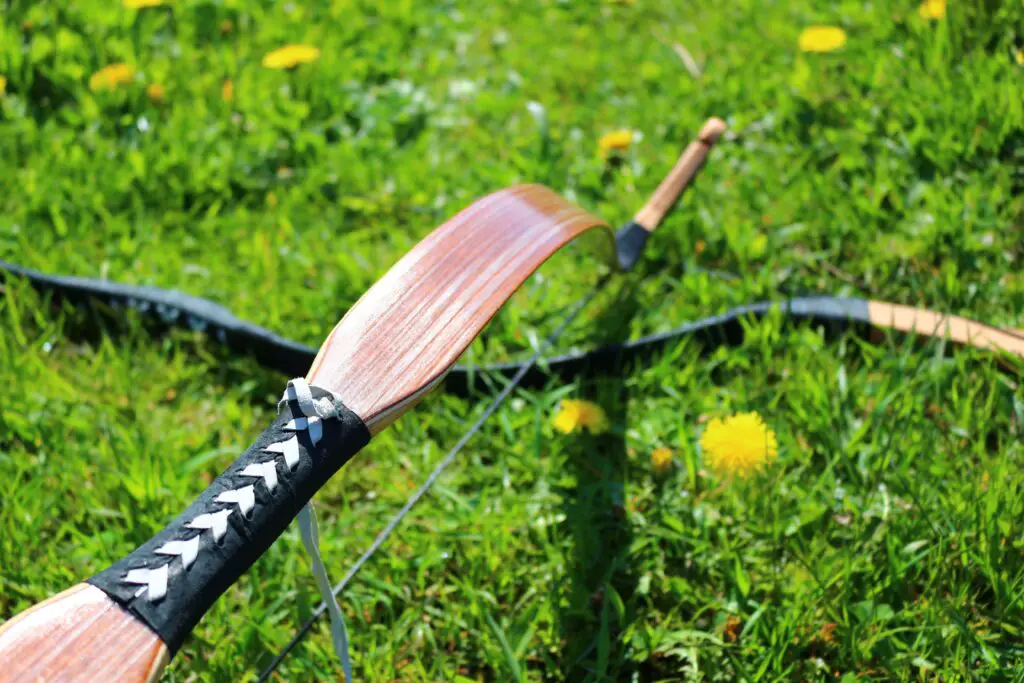
Longbows
Longbows need to be long because they don’t have recurved limbs. Therefore, longbows are more vulnerable when you overdraw it. A good rule of thumb is to buy a longbow that is at least 2 inches taller than the shooter. But the exact recommendation depends on your draw length, how the bow is made and, what wood is used. So, use the manufacturer recommendations if that is possible.
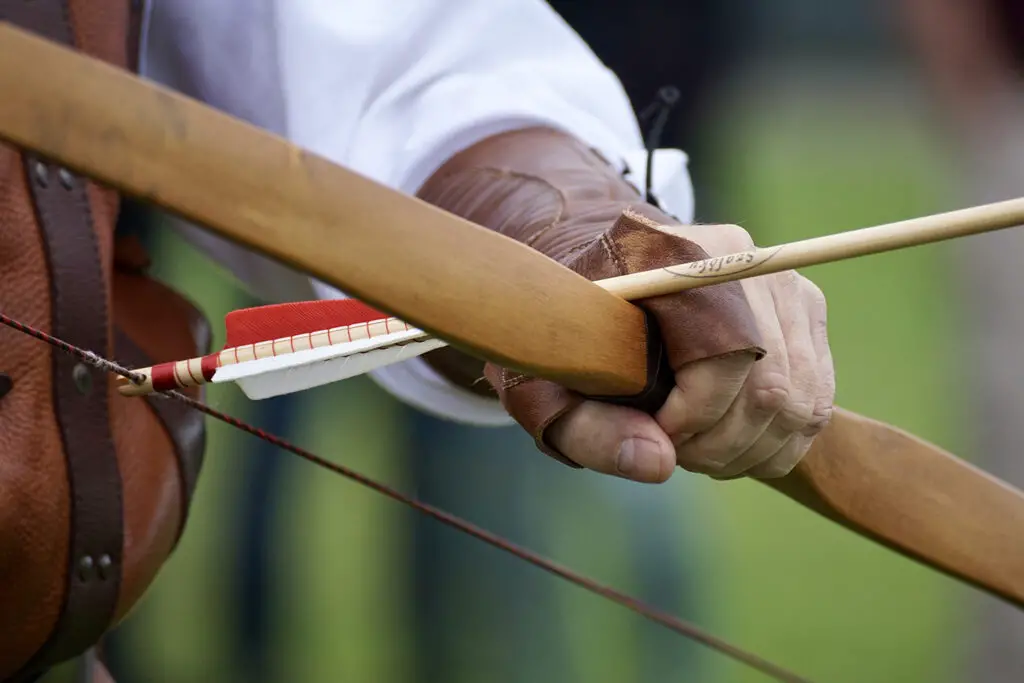
How you can still shoot your short bow
In most cases, the best option is to buy a longer bow. If you have a takedown recurve bow, you only must buy a new set of limbs and a new string. But if that isn’t an option, these two tips below might help you out.
Decrease your draw length
Normally we draw the bow till we are at a certain point on our face. This is what we call our anchor point, and we do this for consistency. Any archer that wants to shoot as accurately as possible should use an anchor point.
If accuracy isn’t a big deal for you and you just want to have fun, you can simply draw back less far. This means that you don’t draw till you hit your face, but you draw to a certain length. Pinpointing this exact length is quite difficult. Therefore, we normally use anchor points. But if you are just plinking around this might not be an issue.
There is a whole community of archers that shoot short bows like this. I shoot my bows for accuracy, so I always draw my bows to full draw. The video below will give you some ideas on how to get yourself started.
Use an extended-release aid
Just like the previous option, you shouldn’t use this tip if you want to partake in competitions. The previous point makes it harder to aim accurately while this makes it easier. Therefore, competitions don’t allow the use of a release aid because it eliminates part of the challenge of shooting a recurve bow.
Therefore, release aids are normally only used on short compound or triangle bows. But if you don’t care about competitions, this might be an option. These release aids are longer than traditional releases. Therefore, you can still anchor at full draw, but the string will be 2 or 3 inches forward.
These release aids are hard to find because they are not used by a lot of archers. But if you google extended release aid compound bow, you will find some options. Read the article below if you want more information on how to shoot a recurve bow with a release aid:
Can you shoot a recurve bow with a release
Final words
Some experienced archers might think the tips at the end might seem rather silly. And indeed, in a target archery setting, it would. But there are also a lot of backyard archers, which are not necessarily competitive. They just want to have fun with their bow. In those situations, these tips might allow you to have fun without investing in new equipment.
If you have any questions, comments, or suggestions, please let me know in the comment section down below! I will respond to any questions as soon as possible and you will receive an email notification when I replied.
Tim van Rooijen
For as long as I can remember, I have always been fascinated by archery. First due to its historic significance but later because I like being outdoors. With this blog, I share my knowledge about Archery and how you can improve your shot. More about author…
